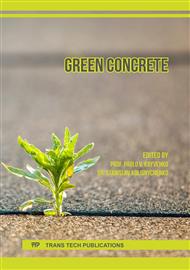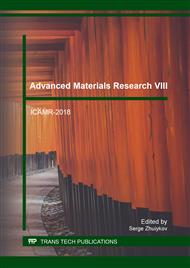p.260
p.269
p.275
p.280
p.285
p.290
p.295
p.300
p.305
Durability of Sustainable Self-Consolidating Concrete
Abstract:
Supplementary cementitious materials such as fly ash, silica fume and ground granulated blast furnace slag (GGBS) have been used widely to partially replace cement in producing self-consolidating concrete (SCC). The production of cement is associated with emission of significant amounts of CO2 and increases the human footprint on the environment. Fly ash, silica fume, and GGBS are recycled industrial by-products that also impart favorable fresh and hardened properties on concrete. This study aims to assess the effect of the amounts of fly ash and silica fume on strength and chloride penetration resistance of concrete. Rapid Chloride Penetration Test (RCPT) was used to assess the ability of SCC to resist ingress of chlorides into concrete. SCC mixes with different dosages of fly ash and silica fume were developed and tested at different curing ages. Test results showed that replacing 20% of cement with fly ash produced the highest compressive strength of 67.96 MPa among all fly ash-cement binary mixes. Results also showed that replacing15% of cement with silica fume produced the highest compressive strength of 95.3 MPa among fly ash-cement binary mixes. Using fly ash and silica fume consistently increased the concrete resistance to chloride penetration at the early ages. Silica fume at all dosages results in low or very low levels of chloride penetration at all curing ages of concrete.
Info:
Periodical:
Pages:
285-289
Citation:
Online since:
March 2018
Authors:
Keywords:
Price:
Сopyright:
© 2018 Trans Tech Publications Ltd. All Rights Reserved
Share:
Citation:



